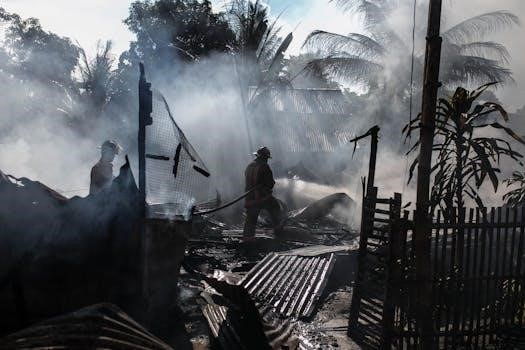Guiding Hazard⁚ An Overview
Guiding Hazard is a manhwa centered on Espers and Guides, exploring their unique bond. It features Lee Taegun, a traumatized Esper, and Seo Eun-seong, his gentle guide, navigating their relationship and its challenges.
Definition of Guiding Hazard in Manhwa Context
In the context of the manhwa Guiding Hazard, the term refers to the perilous and often emotionally charged dynamic between Espers and their Guides. Espers, individuals with extraordinary abilities, require Guides to manage their powers and mitigate negative side effects. However, the guiding process can be traumatic, as experienced by Lee Taegun. The “hazard” aspect stems from the potential for exploitation, emotional distress, and the inherent risks associated with wielding immense power. The manhwa explores how gentle guidance, as demonstrated by Seo Eun-seong, contrasts with previous harsh methods, highlighting the delicate balance required for a healthy Esper-Guide relationship, and the dangers of mismanaging this vital connection.

Character Dynamics in “Guiding Hazard”
The core of Guiding Hazard revolves around the complex relationships between Espers and Guides. The story particularly focuses on the evolving connection between Lee Taegun and Seo Eun-seong and the challenges they face.
Lee Taegun⁚ The Traumatized Esper
Lee Taegun is introduced as the nation’s top S-Class Esper, unmatched in power but deeply affected by past trauma related to guiding. This trauma causes him to refuse guidance, leading to negative side effects from using his abilities. He is initially unapproachable, presenting himself as untouchable.
However, beneath the surface, he struggles with the consequences of his powers and the need for a compatible guide. His past experiences make him wary and suspicious of new guides, especially those who attempt a gentle approach. Taegun’s journey involves confronting his trauma and learning to trust again.
Seo Eun-seong⁚ The Gentle Guide
Seo Eun-seong is a guide who appears in Lee Taegun’s life, offering a different approach to guiding compared to what Taegun has experienced before. Eun-seong employs a gentle and soft guiding style, respecting boundaries and prioritizing Taegun’s comfort. This novel approach immediately makes Taegun suspicious, given his past trauma.
Eun-seong’s character is defined by his patience and understanding, contrasting sharply with previous guides who may have caused Taegun’s trauma. He is determined to guide Taegun, despite the latter’s resistance, presenting an irresistible force meeting an immovable object. His methods challenge Taegun’s preconceived notions about guides.
Themes and Genre
Guiding Hazard blends romance, drama, and the supernatural, with elements of smut and yaoi appealing to mature audiences. The story explores themes of trauma, healing, and the complexities of relationships within a fantastical setting.
Romance and Smut Elements
Guiding Hazard incorporates explicit content suitable for mature readers, intertwining romance with smut elements. The relationship between Lee Taegun and Seo Eun-seong develops amidst these intimate scenes. The manhwa explores the delicate balance of emotional connection and physical attraction. Seo Eun-seong’s gentle approach contrasts with Lee Taegun’s past trauma. This creates a dynamic where trust and vulnerability are central themes.
The narrative carefully navigates the boundaries of consent and healing. It explores the potential for intimacy to be a source of comfort and connection. The romantic and smut elements are integral to the character development. They also drive the plot, offering a nuanced portrayal of a complex relationship in a supernatural world.
Supernatural Aspects
The supernatural forms a core component of Guiding Hazard, with Espers possessing extraordinary abilities that require guidance. Lee Taegun, a powerful S-Class Esper, embodies this supernatural element. His abilities, though potent, come with side effects, highlighting the need for a Guide. The Guides, like Seo Eun-seong, play a crucial role in managing and stabilizing Espers’ powers. They prevent negative consequences and ensure the Espers can function effectively.
The manhwa explores the societal implications of these supernatural abilities. It shows how they influence power dynamics and relationships. The supernatural aspects are not merely a backdrop, but also a driving force behind the plot. They shape character interactions and thematic explorations of trust and control.

Publication Details
Guiding Hazard is authored by Sunsun and illustrated by Chungnyun. It was first released in 2023 and is published by Ridibooks. The manhwa is ongoing and has chapters across two seasons.
Authorship and Release
Guiding Hazard emerges from the creative collaboration of Sunsun, the writer, and Chungnyun, the illustrator. This manhwa first graced the digital pages in 2023, captivating readers with its unique blend of romance, drama, and supernatural elements. The story unfolds with Lee Taegun, an S-Class Esper haunted by past trauma, and Seo Eun-seong, a gentle guide who approaches Taegun with unprecedented care.
The narrative is still in progress and has successfully spanned across two seasons, indicating its popularity and the ongoing demand for its unfolding story. Readers have been drawn into the intricate dynamics between the characters and the intriguing world they inhabit, eager to see where their journey will lead next. The release marked the beginning of an exciting series for fans of the genre.
Publisher
Guiding Hazard finds its home under the publishing umbrella of Ridibooks, a well-known platform for digital comics and web novels. Ridibooks is responsible for the distribution and accessibility of Guiding Hazard to its wide readership. As the publisher, Ridibooks plays a vital role in bringing the creative work of Sunsun and Chungnyun to the public.
The platform offers a space for creators to share their stories and connect with audiences who appreciate diverse genres and narratives. By choosing Ridibooks, Guiding Hazard gains access to a platform that is well-versed in the webtoon and manhwa landscape, allowing it to reach a substantial audience and contribute to the vibrant world of digital storytelling. Ridibooks is a key player in the success of the manhwa.
Hazards in Real-World Context
A hazard is a potential source of harm or adverse health effects on a person. Hazards can lead to injuries, illnesses, property damage, or environmental degradation, impacting overall well-being.
Definition of a Hazard
A hazard is defined as any dangerous phenomenon, substance, human activity, or condition that has the potential to cause harm. This harm can manifest as loss of life, injury, or other health impacts, as well as property damage and loss of livelihoods; Hazards can also lead to social and economic disruption, or environmental damage. In the context of occupational safety and health, a hazard is the potential to cause injury or illness and can apply to substances, methods, or machines. Identifying hazards is a crucial step in preventing accidents and promoting a safe environment, whether at work or in daily life. Addressing hazards proactively minimizes risks and protects individuals and assets from potential harm.
Examples of Hazards
Hazards manifest in diverse forms across various environments. In workplaces, examples include housekeeping hazards, such as clutter and spills, which can lead to slips and falls. Hazardous chemicals pose risks of exposure and health issues. Unguarded machinery and equipment constitute safety hazards. Electrical hazards, such as exposed wires, present shock and fire dangers. Environmental hazards include natural disasters like earthquakes and floods. Human activities can also be hazardous, for example, improper handling of dangerous substances or negligent operation of vehicles. Identifying and addressing these hazards is crucial for mitigating risks and preventing accidents. Taking proactive measures ensures the safety and well-being of individuals and protection of property. Recognizing diverse hazard types enhances awareness and preparedness.

Workplace Safety and Hazard Management
Workplace safety involves identifying and mitigating hazards to prevent injuries and illnesses. Effective hazard management includes risk assessment and control methods, ensuring a safe and healthy environment for all employees.
Hazard Identification
Hazard identification is a critical component of workplace safety. It involves systematically identifying potential sources of harm, damage, or adverse health effects. This includes recognizing physical hazards like housekeeping issues and tripping hazards, which should be addressed immediately. Identifying hazards emphasizes safety and provides leadership opportunities.
Effective identification requires awareness of workplace conditions and activities. Organizations must be proactive in finding potential risks. Tools like ECAST guidance can aid in this process. Identifying and immediately fixing hazards promotes a culture of safety. This ensures a safer work environment, reducing the likelihood of injuries and illnesses among employees.
Risk Assessment and Control Methods
Risk assessment follows hazard identification, evaluating the potential for harm from identified hazards. It determines the likelihood and severity of potential incidents. Control methods are then implemented to minimize or eliminate these risks. These methods may include engineering controls, such as modifying equipment or processes, and administrative controls, like safety procedures and training.
Proper risk assessment and control are vital for maintaining a safe working environment. They ensure that appropriate measures are in place to protect employees. Regularly reviewing and updating risk assessments is crucial, as workplace conditions can change. This proactive approach helps prevent accidents and promote a culture of safety.

Regulatory Frameworks
Regulatory frameworks like Cal/OSHA and joint OSHA/Health Canada guidelines establish standards for workplace safety. They provide a structure for hazard management and ensure compliance with safety regulations and laws.
Cal/OSHA Regulations
Cal/OSHA, California’s Division of Occupational Safety and Health, is dedicated to protecting the health and safety of California’s workforce.
This is achieved through various activities including workplace inspections, enforcement of safety regulations, and consultation services for employers. Cal/OSHA also safeguards passengers on elevators, amusement rides, and tramways.
The agency enforces standards related to hazard communication, ensuring employers properly identify and communicate potential hazards to employees.
These regulations cover a wide array of workplace hazards and are crucial for maintaining a safe and healthy work environment in California.
By adhering to Cal/OSHA regulations, employers can significantly reduce workplace accidents and illnesses.
Joint OSHA/Health Canada Guidelines
OSHA (Occupational Safety and Health Administration) in the US and Health Canada collaborate on guidelines for hazardous products in the workplace.
This collaboration ensures consistent safety standards across borders, particularly concerning labeling requirements for hazardous chemicals.
The joint effort aims to streamline regulatory processes and provide clear guidance for employers and workers dealing with hazardous materials.
These guidelines focus on hazard communication, ensuring that information about potential risks is effectively conveyed through labels and safety data sheets.
The collaboration reflects a commitment to protecting worker health and safety through harmonized standards and practices.
By working together, OSHA and Health Canada enhance workplace safety and promote a safer environment for employees handling hazardous products.
These guidelines are updated periodically to reflect the latest scientific knowledge and regulatory changes.
